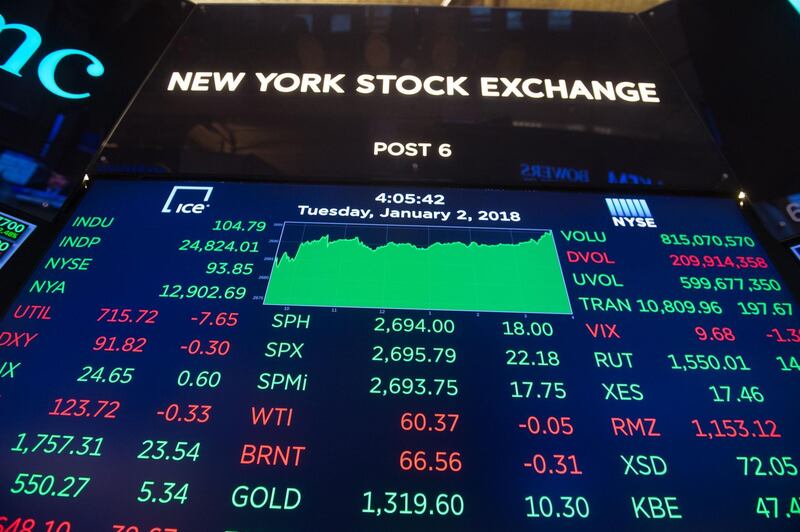The S&P 500 and the Nasdaq Composite notched record closing highs on Tuesday, the first trading day of 2018, while European equities finished lower and the US dollar fell to its weakest level in over three months against key currencies.
MSCI's gauge of stocks across the globe gained 0.74 per cent. In 2017 the index set scores of record highs and rose by one-fifth in value.
Major stock indexes closed 2017 with their best performance since 2013. In the US market, the advance came amid strong economic growth and corporate earnings, low interest rates and hopes, now realised, of US corporate tax cuts.
The US equity indexes closed higher on Tuesday, buoyed by gains in technology and consumer discretionary stocks.
The Dow Jones Industrial Average rose 104.79 points, or 0.42 per cent, to 24,824.01, the S&P 500 gained 22.18 points, or 0.83 per cent, to 2,695.79, and the Nasdaq Composite added 103.51 points, or 1.5 per cent, to 7,006.90.
"We're off to the races once again," said Stephen Massocca, senior vice president at Wedbush Securities in San Francisco.
"I don't expect the kind of moves we saw last year," he said. "But as long as monetary policy stays the way it is ... my view is stocks are going to have a decent year. And fiscal policy has become stimulative as well given the tax bill."
In Europe, equities closed lower, weighed by a decline in autos stocks following weaker car registrations data. Trading was also cautious ahead of the launch of a major reform of European financial markets.
The pan-European STOXX 600 index fell 0.21 per cent, and euro zone stocks shed 0.19 per cent.
Shares rose in Asia. Shanghai blue chips climbed 1.41 per cent and MSCI's 24-country emerging market stock index jumped to a multi-year high after the Caixin index of Chinese industry rose to a four-month high of 51.5 in December, confounding forecasts for a decline. The 50-mark divides expansion from contraction.
The dollar index, which tracks the greenback against a basket of major currencies, fell 0.29 per cent, hampered by expectations of a slower pace of interest rate increases by the Federal Reserve amid a tepid US inflation picture.
_______________
Read more:
[ Active fund managers have their chance at long last ]
[ US stocks retreat on final trading day of 2017 ]
_______________
The dollar hit a three-month low on Friday, bringing its losses for 2017 to 9.8 per cent, its worst performance since 2003.
Other currencies gained. The euro rose 0.39 per cent to $1.2055 and hit a four-month high on Tuesday after data showed that euro zone manufacturers ramped up activity last month at the fastest pace in more than two decades.
The Japanese yen strengthened 0.32 per cent at 112.29 per dollar, while sterling was last trading at $1.3594, up 0.69 per cent.
U.S. Treasury yields rose in line with European government yields. A European Central Bank official said the ECB's massive bond purchase program might not continue later this year.
A reversal of year-end buying has also driven U.S. Treasury yields higher, said Brian Rehling, co-head of global fixed income strategy for Wells Fargo Investment Institute in St. Louis.
"Lots of institutions buy Treasuries to hold over year-end for liquidity. To see that reversal early in the year is not a surprise," Mr Rehling said.
Benchmark US 10-year notes last fell 14/32 in price to yield 2.4597 per cent, from 2.411 per cent late on Friday.
Oil prices earlier enjoyed their strongest start to a year since 2014 but fell lower as major pipelines in Libya and Britain's North Sea restarted and US production soared to the highest level in more than four decades.
US crude last fell 0.1 per cent to $60.36 per barrel and Brent was at $66.53, down 0.51 per cent.
Copper lost 0.42 per cent to $7,216.50 a tonne, following a rise of 31 per cent in 2017 to a four-year top.
Spot gold added 1.2 per cent to $1,317.69 an ounce, after advancing by 13 per cent in 2017 for its best performance in seven years.






